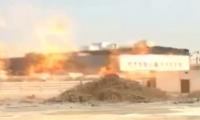Since his ouster from power in April 2022, former prime minister Imran Khan adopted a high-risk strategy to regain power and outmaneuver his political opponents. His main objective was to dislodge the current coalition government and regain power through elections.
But he miscalculated his chances and used high-risk tactics to achieve his target. There is no denying that Khan’s ouster resulted in increasing his popularity, and he was in a much better position to win elections without adopting any high-risk strategies or tactics.
The Shehbaz Sharif-led coalition government has become unpopular due to the dismal economic situation. The record high inflation and economic slowdown have made the lives of ordinary people miserable. The PML-N has lost considerable support in Punjab. Khan could have played well to capitalize on this. But he never accepted the fact that he was outsmarted by his political opponents. Khan became over ambitious. Otherwise, a year is not a long time in politics, and Khan could have shown patience.
In traditional power politics, political players use minimum risk to achieve their ultimate goal. One needs pressure tactics and patience. Sometimes, it becomes necessary to take two steps back to move forward. Previously, many people criticized the strategy adopted by the PPP and PML-N while in opposition. Both parties were targeted, and several politically motivated cases were initiated against their leaders who were arrested and humiliated.
But the parties patiently waited for the right time to bounce back. They combined pressure tactics with negotiation skills. And this combination worked well for them. They organized peaceful public rallies across the country and criticized the political role of certain quarters. When some PDM parties tried to abandon parliament, the PPP fiercely opposed the move. The later events vindicated the PPP’s position.
Contrary to this, Khan relied heavily on street protests but failed to put enough pressure on the government and state institutions through street mobilisation. He overestimated his street power and underestimated the strength of his opponents.
Khan also relied on certain elements within the state structure that were sympathetic to him. This was again a high-risk strategy with dire consequences in the case of failure. Those elements kept his ship afloat and rescued him whenever he cornered himself. But they failed to provide him the support he needed to regain power.
Last year was full of mistakes. He prematurely decided to resign from the National Assembly without realizing that the PTI was in a much better position to play the role of opposition with the strength of nearly 150 MNAs. The decision to resign made the government’s time in parliament much easier.
He organized two long marches towards Islamabad to force the government to resign and hold fresh elections, but he failed on both occasions. He did not change his high-risk strategy after the failure of the first long march on May 25, 2022 and certainly did not learn the necessary lessons from that failure. He dissolved the Punjab and Khyber Pakhtunkhwa assemblies to achieve his objective of conducting fresh elections without thinking about the consequences of his decision.
Khan also misjudged the mood of the powerful quarters and alienated himself from political structures. And while he succeeded in creating political instability and destabilizing the political system to some extent, those decisions and actions failed to lead to desired results.
The decision to resist his arrest at any cost proved fatal for his party. It does not make any sense to call the arrest of a party leader a matter of life and death. This was once again a high-risk strategy. He became a ‘red line’ for the party, with Khan using his party activists as a human shield. The initial success of party workers in resisting the arrest strengthened them. The May 9 events were the outcome of the strategy Khan had been using for a long time.
The dire situation in which the PTI and Khan currently find themselves is the result of the high-risk strategies adopted to achieve their objectives. The PTI failed to realistically analyze the situation and change its strategy and tactics accordingly.
Today, the PTI is facing an existential crisis. The mass exodus continues, and the party is melting like ice on a hot summer day. More than 65 leaders and ticket holders have left the party since the May 9 violence. Many more are likely to leave in the coming days and weeks. The party has lost many familiar faces including Fawad Chaudhry, Maleeka Bokhari and Mussarat Cheema. Not only are electables leaving the party, but close aides of Khan are also leaving.
It is not surprising at all that the electables are leaving the PTI because they are known for jumping ship – they only place bets on a winning horse. But the real setback for the party and Khan is the decision of leaders like Amir Kayani, Senator Saifullah Nyazee and Maleeka Bokhari to quit.
Khan is still not ready to mend ways. He has destroyed the party he built over the years for his personal ego and political ambitions. Time is running out fast for the PTI.
The writer is a freelance journalist.
Critics argue that strategy is vague, but closer look indicates strategic alignment with global trends and national...
To defeat it, we must distrust bot-driven narratives, to defeat it, we must verify sources before believing or sharing
Too often in emerging markets, digital innovation is treated as standalone goal, with risk relegated to afterthought
As in Pakistan lawfare’s impact and prevalence are increasing, situation is turning murkier
Number of traditions are associated with Eid, such as new clothes and giving and receiving of cash gifts as Eidi
Internationally, there have been misleading theories propounded about so-called slowing of Chinese economy







